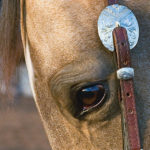Your horse got mixed up with something he shouldn’t have out in the field. He’s cut badly. There’s blood everywhere. What can you do to stop that gush of red before taking the time to call your veterinarian?

1. The bits of tape trace the most likely sites of arterial bleeding: the arteries over the back of the sesamoid bone and down the back of the pastern…
2. …and the metatarsal artery next to the splint bone in the hind leg.
3. While only a few arteries are close to the surface of the legs, many veins are; here tape marks the saphenous vein on the inside of the hock.

4. Start with a wad of clean gauze–an inch-thick stack of gauze pads, or a whole roll of gauze; just take the gauze out of its sterile wrappings and press it on the wound.
5. Over that, wrap a roll of gauze to keep the wad in place…
6. …then a layer of padding–a quilt or sheet cotton–as you would for a support bandage, smoothing out any wrinkles so you don’t create uneven pressure.

7. Hold everything in place with a wrap that applies snug, slightly even pressure: Vetrap (shown here) or Elastikon or a knit stable bandage. Don’t start at the very bottom, though; as I’m doing here, leave some padding sticking out at the top and bottom to make sure you’re not putting too much pressure directly on the tissues of the leg. (I don’t recommend Ace bandages for this use because they’re easy to over-tighten; if an Ace bandage is all you have in an emergency, be super-careful not to pull it too tight.)
8. If the wound bleeds through, DON’T TAKE OFF THE BANDAGE! You’ll only disrupt whatever clotting has taken place. Instead, add pressure with a second layer of gauze pads…
9. …then a snug wrap of Elastikon (which I’m using here) or Vetrap…

10. …smoothing it down to make it stick.
11. Top that with another layer of padding and then a knit stable bandage, wrapping normally but…
12. …again leaving some of the padded layer unwrapped at top and bottom. In most cases, the wound will eventually clot even without these layers, but they may speed the process a little.
–Photos by Mandy Lorraine
Dr. Susan Crane is a 1982 graduate of the University of Pennsylvania’s School of Veterinary Medicine and has competed in eventing through Training level. As well as practicing at her alma mater’s New Bolton Center large-animal facility, she has worked at the University of North Carolina’s veterinary school and in private practice. She says that her specialty, equine field service, “includes everything” and she has worked with broodmares, racehorses, pleasure horses and performance horses of most disciplines.
This story was excerpted from “Stop the Bleeding!” which originally appeared in the July 1996 issue of Practical Horseman magazine. For guidelines on how to deal with all types of wounds, see the Health Care story in the August 2005 issue.





